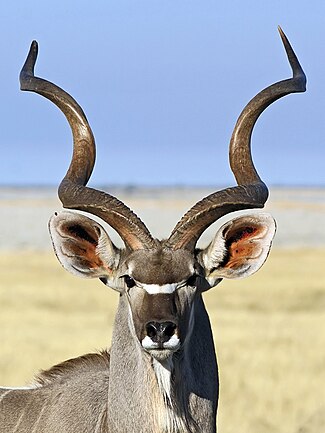Template:POTD/2019-11-09
Appearance
The greater kudu (Tragelaphus strepsiceros) is a species of woodland antelope in the genus Tragelaphus found throughout eastern and southern Africa. Despite occupying widespread territory, they are sparsely populated in most areas due to declining habitat, deforestation and poaching. The greater kudu is one of two species commonly known as kudu, the other being the lesser kudu, T. imberbis. Greater kudus have a narrow body with long legs, and their coats can range from brown or bluish grey to reddish brown. They possess between four and twelve vertical white stripes along their torso. The head tends to be darker in colour than the rest of the body, and exhibits a small white chevron running between the eyes. The helical horns of adult males grow as the animal ages, reaching 2+1⁄2 rotations at about 6 years old.
This picture shows a greater kudu bull photographed near Groot Okevi in Etosha National Park, Namibia. Bulls weigh 190–270 kg (420–600 lb), up to a maximum of 315 kg (690 lb), and stand up to 160 cm (63 in) tall at the shoulder.Photograph credit: Hans Hillewaert
| This picture of the day has been featured on Portal:Mammals. |

